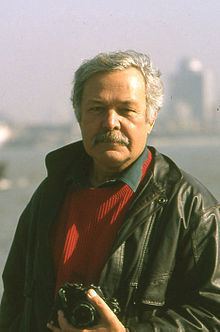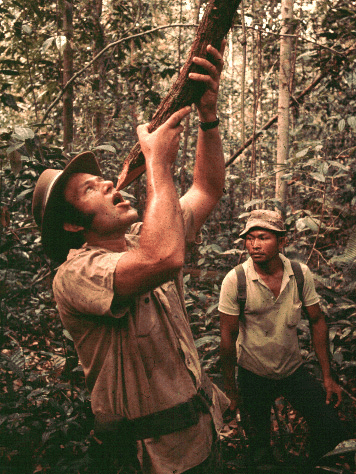Occupation Author Role Author Name Harold Stephens | Period 1957-present Nationality American | |
 | ||
Born December 3, 1926Bridgeville, PA, Pennsylvania, U.S. ( 1926-12-03 ) Books Take China, At home in Asia, The tower and the river, The last voyage, Return to Adventure Southeas | ||
Harold Stephens (December 3, 1926) is an American author known for his explorations of World War II, China and his world travels and adventures.
Contents

Biography
Harold Stephens was born in Bridgeville, Pennsylvania, and was raised on a nearby farm. When the farmhouse burned down, he went to work in the coal mines and later in the steel mills. A month before his seventeenth birthday, he lied about his age to enlist in the United States Marine Corps. Four months later fought in the Battle of Okinawa. When the war ended in 1945, he went to China as a China Marine. He landed in Tsingtao, attended the Chinese language school, and become an interpreter. He remained in China until the communist revolution in 1949.
Back home again and not wanting to return to the steel mills, Stephens re-enlisted in the Marine Corps, He was sent to Paris as a Marine Security Guard, and became an aide to the American Ambassador, Jefferson Caffery. Stephens met and married an American who was working in Paris. Realizing the need for an education, they returned to America. He took his discharge, and with an appointment from Ambassador Caffery, entered the Foreign Service School, Georgetown University. One of his classmates was Jackie Kennedy, wife of then Senator John F. Kennedy.
Graduating from Georgetown in 1955, Stephens studied law, but ultimately dropped out to work with the National Security Agency. He soon decided that working for the government was far worse than the steel mills of Pennsylvania. At the same time, his marriage began to crumble; he and his wife divorced.
Stephens long career as a writer began as a Marine in China, when he started writing short stories and skits. While working for the government in Washington, he wrote travel articles for the Washington Post. After his divorce, he decided to write full-time. He resigned from the National Security Agency and embarked on a life of travel and adventure. He moved to Tahiti to live, but left when the French turned the islands into a nuclear testing ground, and moved to Asia. He joined a camel caravan in Kabul, Afghanistan, crossing the country on a camel. He also hiked in Tibet and traveled deep into Bhutan. He finally went to Spain, where he could write and live inexpensively. There he met Ernest Hemingway, James Michener, Anthony Quinn, Ava Gardner and the great bullfighters of the time, including American bullfighter John Fulton (Short). Michener became a good friend and encouraged Stephens to continue his writing.
Stephens eventually returned to Southeast Asia, where he joined the staff of the Bangkok Post and also became a travel correspondent for Royal Orchid Holidays at Thai Airways, a position he still holds.
Stephens married again, this time to Michelle, an Asian woman at the Bangkok Post who was very understanding and supported his wandering ways and writing. They have three sons, all who attended colleges in the United States. Paul, the youngest, graduated from Berkeley. Denise, his daughter from his first marriage, is a successful stockbroker, while his older son, Peter, is a rancher.
Stephens has written more than 25 books and about 4,500 magazine and newspaper articles. He is currently writing about the expatriate artists of Bali and plans to build another schooner in Singapore with his nephew, photographer Robert Stedman, to explore the rivers of Asia. His also outfitting a vehicle for a motor drive across China into Tibet and Mongolia.
Works
The subject matter for Stephens’ books comes from his travel and adventure experiences. In Who Needs a Road? he tells the story of driving a Toyota Land Cruiser 42 252 miles around the world, setting the record for the longest motor trip. In The Last Voyage – The Story of Schooner Third Sea he tells of building and outfitting a schooner that he sailed for 18 years around the Pacific and Asian waters, including many rivers of Asia. From aboard Schooner Third Sea he dove on wrecks and discovered HMS Repulse and President Kennedy’s PT-109 but was run out before he could salvage the wreck. From his experiences in China he wrote Take China, The Last of the China Marines, and from his time in Paris as aid to Ambassador Jefferson Caffery came his novel The Tower & The River. In his travels Stephens wrote about the people he met, treasure divers, pirate chieftains, expat tycoons, renegade artists, and it is these characters who appears in his books At Home in Asia and Tales from the Pacific Rim.
He began exploring the Oriental Jungle with the Malay Game Warden (who became a close friend), taking stock of the wild elephants, rhino, tigers and other wildlife. The jungle trips and his search for lost cities and Khmer ruins gave him good story material for Return to Adventure Southeast Asia.
He also writes about history in For the Love of Siam, The Story of King Narai and His Greek Foreign Minister, and he reveals his trade secrets on becoming a writer in The Education of a Travel Writer.
